#solar panel system performance
Explore tagged Tumblr posts
Text
Understanding Solar Performance Ratio: The Key Metric for PV System Efficiency
Solar energy has become an increasingly popular and viable option for clean, renewable power. As more individuals and businesses invest in photovoltaic (PV) systems, it’s crucial to understand how to measure and optimize their performance. One of the most important metrics in this regard is the Solar Performance Ratio (PR).

What is Solar Performance Ratio?
The Solar Performance Ratio is a measure of the overall efficiency and quality of a PV system. It compares the actual energy output of a solar installation to its theoretical maximum output, taking into account various factors that can affect performance. Expressed as a percentage, the PR provides valuable insights into how well a system is performing relative to its potential.
Calculating Performance Ratio
The formula for calculating PR is:
PR = (Actual Energy Output) / (Theoretical Maximum Energy Output)
The actual energy output is simply the amount of electricity produced by the system over a given period. The theoretical maximum output, however, requires considering several factors:
Solar irradiance at the site
Panel efficiency
System size (in kWp)
Temperature effects
Other system losses (e.g., inverter efficiency, wiring losses)
Why is Performance Ratio Important?
System Health Indicator: A high PR (typically 80% or above) indicates that a PV system is performing well and efficiently converting sunlight into usable electricity.
Comparison Tool: PR allows for fair comparisons between different PV systems, regardless of their size or location.
Problem Detection: A sudden drop in PR can alert system owners to potential issues like shading, soiling, or equipment malfunctions.
Financial Implications: Higher PR translates to better energy production and, consequently, greater financial returns on the solar investment.
Factors Affecting Performance Ratio
Several factors can influence a system’s PR:
Environmental Conditions: Temperature, shading, and soiling can all impact performance.
Equipment Quality: High-quality panels, inverters, and other components generally lead to better PR.
System Design: Proper system design, including optimal tilt and orientation of panels, contributes to higher PR.
Maintenance: Regular cleaning and maintenance help maintain a high PR over time.
Improving Your System’s Performance Ratio
To optimize your PV system’s PR:
Conduct regular maintenance and cleaning
Use high-quality, efficient components
Ensure proper system design and installation
Monitor performance regularly and address issues promptly
Consider advanced technologies like solar trackers or bifacial panels
Understanding and optimizing your solar system’s Performance Ratio is key to maximizing its efficiency and your return on investment. By focusing on this crucial metric, you can ensure that your PV system continues to perform at its best, delivering clean, renewable energy for years to come.
#solar#solar power#solar energy#renewable energy#photovoltaic systems#solar panel efficiency#energy efficiency#sustainability#climate change#solar performance ratio#PV system performance index#solar energy system efficiency#solar power system efficiency#renewable energy system efficiency#solar panel system performance#solar energy efficiency ratio#solar power efficiency ratio#renewable energy efficiency ratio#solar energy efficiency index#solar power efficiency index#renewable energy efficiency index
0 notes
Text
#Solar Panels Installation Why aren't there solar-powered cars?#How do solar plant monitoring systems drive maximum performance?#How much electricity can a solar panel system generate?
0 notes
Text

#solar panels#solar energy#solar#solar power#solar system#It is crucial to make sure that the quality of solar panels remains intact for long-lasting performance. Buy solar panels from certified so#and consider the warranty and degradation rate of the panels.#Visit our Website :https://cloudjetsolar.com/#Contact US: 8989919138/78
0 notes
Text
What Happens To Solar Water Heater in Winter?
What Happens To Solar Water Heater in Winter?
Winter has arrived, and with it comes shorter days and chillier temperatures. This may leave you wondering what happens to your trusty solar water heater during these colder months. Can it still provide you with steaming hot showers and toasty dishes? The answer is yes, with a few caveats.What happens to solar water heater in winter?Buy a solar water heater in winter month from Jupiter Solar,www.jupitersolars.in.
How Does Winter Affect Solar Water Heaters?
Reduced Sunlight: The main challenge for solar water heaters in winter is the reduced amount of sunshine. Shorter days and cloudier skies mean less solar energy to absorb and convert into heat. This naturally results in lower water temperatures compared to the sunny summer months.

Cold ambient temperatures: The frigid air acts as a heat sink, drawing warmth away from the solar collectors and the storage tank. This can further contribute to a slight dip in water temperature.
Freeze Protection: In harsher winter climates, freezing temperatures are a concern. Most modern solar water heaters have built-in freeze protection measures like antifreeze solutions or drain valves to prevent damage.
So, How Hot Will My Water Be?
While you may not achieve the same scorching temperatures as in summer, your solar water heater can still perform admirably in winter. The extent of the temperature drop depends on several factors like:
System size and efficiency: Larger, well-insulated systems will fare better than smaller or older ones. Climate and sun exposure: Sunny regions with milder winters will see less impact compared to areas with prolonged cloudy skies and freezing temperatures. Backup system availability: Many systems integrate with auxiliary electric or gas heaters to boost water temperature on demand during peak demand or periods of low solar energy.
Tips for Optimal Winter Performance:
Regular maintenance: Ensure your system is clean and free of debris to maximize sun absorption. Monitor water temperature: Keep an eye on your tank temperature and adjust settings on your control panel if necessary. Utilize backup systems: Don't hesitate to use your backup heater for peak demand periods or on days with minimal sunshine. Upgrade when needed: If your system consistently struggles in winter, consider upgrading to a larger or more efficient unit.
Conclusion:
Winter doesn't spell doom for your solar water heater. While you may notice slightly cooler water temperatures, some strategic adjustments and a good backup system can ensure you still enjoy the benefits of solar-powered hot water throughout the year. Keep your system maintained, understand its limitations, and embrace the power of backup options for warm showers and a happy winter season!
#solar water heater#solar energy#bangalore#india#solar#solar water heaters#bengaluru#solar water heating#solar heater#water#Tips for Optimal Winter Performance#How Hot Will My Water Be#How Does Winter Affect Solar Water Heaters#What Happens To Solar Water Heater in Winter#solar panel#solar heaters#hot water systems#hot water#heaters#solar water heater in winter#winter#heater
1 note
·
View note
Text
#solar inverter#solar inverters#solar energy system#solar panel inverters#energy-saving inverters#best solar inverters#high-performance solar inverter
0 notes
Text
"As solar panels heat up beyond 25°C, their efficiency decreases markedly. Green roofs moderate rooftop temperatures. So we wanted to find out: could green roofs help with the problem of heat reducing the output of solar panels?
Our research compared a “biosolar” green roof — one that combines a solar system with a green roof — and a comparable conventional roof with an equivalent solar system. We measured the impacts on biodiversity and solar output, as well as how the plants coped with having panels installed above them.
The green roof supported much more biodiversity, as one might expect. By reducing average maximum temperatures by about 8°C, it increased solar generation by as much as 107% during peak periods. And while some plant species outperformed others, the vegetation flourished.
These results show we don’t have to choose between a green roof or a solar roof: we can combine the two and reap double the rewards...
How did the panels affect the plants?
In the open areas, we observed minimal changes in the vegetation cover over the study period compared to the initial planted community.
Plant growth was fastest and healthiest in the areas immediately around the solar panels. Several species doubled in coverage. We selected fast-growing vegetation for this section to achieve full coverage of the green roof beds as soon as possible.
The vegetation changed the most in the areas directly below and surrounding the solar panels. The Baby Sun Rose, Aptenia cordifolia, emerged as the dominant plant. It occupied most of the space beneath and surrounding the solar panels, despite having been planted in relatively low densities.
This was surprising: it was not expected the plants would prefer the shaded areas under the panels to the open areas. This shows that shading by solar panels will not prevent the growth of full and healthy roof gardens.
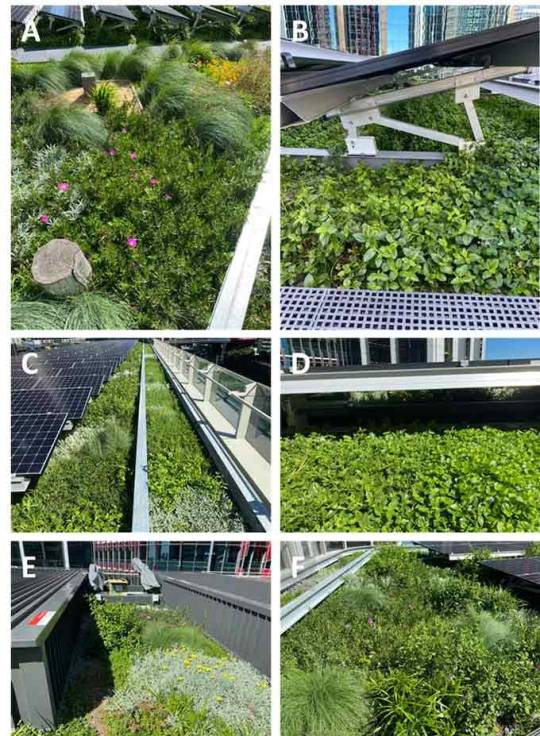
What were the biodiversity impacts?
We used environmental DNA (eDNA) surveys to compare biodiversity on the green roof and conventional roof. Water run-off samples were collected from both roofs and processed on site using portable citizen scientist eDNA sampling equipment to detect traces of DNA shed by the species on the roof.
The eDNA surveys detected a diverse range of species. These included some species (such as algae and fungi) that are not easily detected using other survey methods. The results confirmed the presence of bird species recorded by the cameras but also showed other visiting bird species went undetected by the cameras.
Overall, the green roof supported four times as many species of birds, over seven times as many arthropods such as insects, spiders and millipedes, and twice as many snail and slug species as the conventional roof. There was many times the diversity of microorganisms such as algae and fungi.
Encouragingly, the green roof attracted species unexpected in the city. They included blue-banded bees (Amegilla cingulata) and metallic shield bugs (Scutiphora pedicellata).
How did the green roof alter temperatures?
The green roof reduced surface temperatures by up to 9.63°C for the solar panels and 6.93°C for the roof surfaces. An 8°C reduction in average peak temperature on the green roof would result in substantial heating and cooling energy savings inside the building.
This lowering of temperatures increased the maximum output of the solar panels by 21-107%, depending on the month. Performance modelling indicates an extensive green roof in central Sydney can, on average, produce 4.5% more electricity at any given light level.
These results show we don’t have to choose between a green roof or a solar roof. We can combine them to take advantage of the many benefits of biosolar green roofs.
Biosolar roofs can help get cities to net zero
The next step is to design green roofs and their plantings specifically to enhance biodiversity. Green roofs and other green infrastructure may alter urban wildlife’s activities and could eventually attract non-urban species.
Our green roof also decreased stormwater runoff, removed a range of run-off pollutants and insulated the building from extremes of temperature. A relatively inexpensive system provides all of these services with moderate maintenance and, best of all, zero energy inputs.
Clearly, biosolar green roofs could make major contributions to net-zero cities. And all that’s needed is space that currently has no other use."
-via GoodGoodGood, May 12, 2024
#green#green roof#biosolar#solar power#solar panels#rooftop solar#solarpunk#native plants#australia#sydney australia#biodiversity#conservation#climate change#climate action#climate hope#global warming#temperature#climate adaptation#cooling#good news#hope
2K notes
·
View notes
Text
Mariner program
The Mariner program was conducted by the American space agency NASA to explore other planets. Between 1962 and late 1973, NASA's Jet Propulsion Laboratory (JPL) designed and built 10 robotic interplanetary probes named Mariner to explore the inner Solar System - visiting the planets Venus, Mars and Mercury for the first time, and returning to Venus and Mars for additional close observations.

The program included a number of interplanetary firsts, including the first planetary flyby, the planetary orbiter, and the first gravity assist maneuver. Of the 10 vehicles in the Mariner series, seven were successful, forming the starting point for many subsequent NASA/JPL space probe programs.
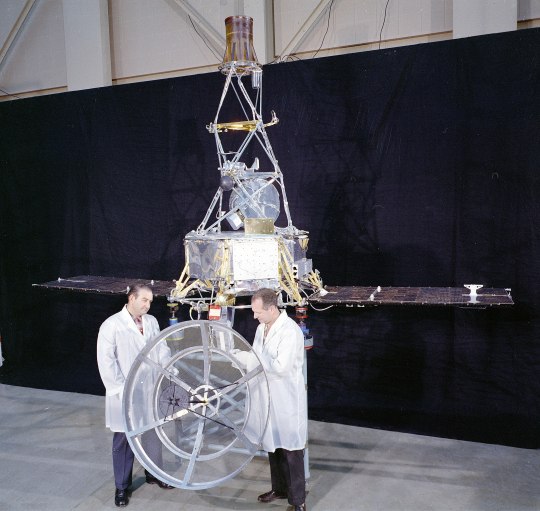
The name of the Mariner program was decided in "May 1960-at the suggestion of Edgar M. Cortright" to have the "planetary mission probes ... patterned after nautical terms, to convey 'the impression of travel to great distances and remote lands.'" That "decision was the basis for naming Mariner, Ranger, Surveyor, and Viking probes."

Each spacecraft was to carry solar panels that would be pointed toward the Sun and a dish antenna that would be pointed at Earth. Each would also carry a host of scientific instruments. Some of the instruments, such as cameras, would need to be pointed at the target body it was studying. Other instruments were non-directional and studied phenomena such as magnetic fields and charged particles. JPL engineers proposed to make the Mariners "three-axis-stabilized," meaning that unlike other space probes they would not spin.

Mariner 1 and Mariner 2
Mariner 1 and Mariner 2 were two deep-space probes making up NASA's Mariner-R project. The primary goal of the project was to develop and launch two spacecraft sequentially to the near vicinity of Venus, receive communications from the spacecraft and to perform radiometric temperature measurements of the planet. A secondary objective was to make interplanetary magnetic field and/or particle measurements on the way to, and in the vicinity of, Venus.

Animation of Mariner 2's trajectory from August 27, 1962, to December 31, 1962. Mariner 2 · Venus · Earth.
Mariners 3 and 4
Sisterships Mariner 3 and Mariner 4 were Mars flyby missions.
Mariner 3 was launched on November 5, 1964, but the shroud encasing the spacecraft atop its rocket failed to open properly and Mariner 3 did not get to Mars.
Mariner 4, launched on November 28, 1964, was the first successful flyby of the planet Mars and gave the first glimpse of Mars at close range

This archival image is an enhanced contrast version of the first Mars photograph released on July 15, 1965. This is man's first close-up photograph of another planet -- a photographic representation of digital data radioed from Mars by the Mariner 4 spacecraft. Data was either sent to Earth immediately for acquisition or stored on an onboard tape recorder for later transmission.

The pictures, played back from a small tape recorder over a long period, showed lunar-type impact craters (just beginning to be photographed at close range from the Moon), some of them touched with frost in the chill Martian evening.
Mariner 5
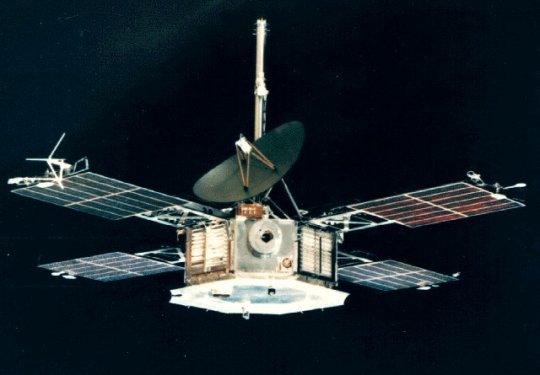
The Mariner 5 spacecraft was launched to Venus on June 14, 1967, and arrived in the vicinity of the planet in October 1967. It carried a complement of experiments to probe Venus' atmosphere with radio waves, scan its brightness in ultraviolet light, and sample the solar particles and magnetic field fluctuations above the planet.
Mariners 6 and 7

Mariners 6 and 7 were identical teammates in a two-spacecraft mission to Mars. Mariner 6 was launched on February 24, 1969, followed by Mariner 7 on March 21, 1969. They flew over the equator and southern hemisphere of the planet Mars.
Mariners 8 and 9

Mariner 8 and Mariner 9 were identical sister craft designed to map the Martian surface simultaneously, but Mariner 8 was lost in a launch vehicle failure. Mariner 9 was launched in May 1971 and became the first artificial satellite of Mars.
Mariner 10
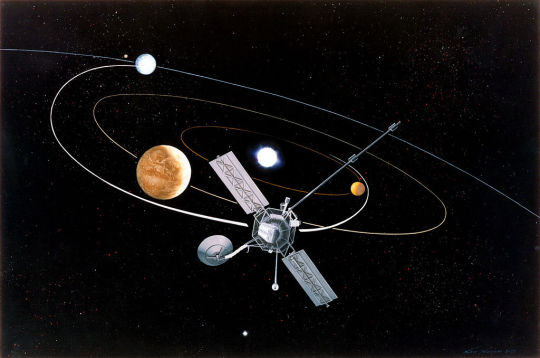
The Mariner 10 spacecraft launched on November 3, 1973, and was the first to use a gravity assist trajectory, accelerating as it entered the gravitational influence of Venus, then being flung by the planet's gravity onto a slightly different course to reach Mercury. It was also the first spacecraft to encounter two planets at close range, and for 33 years the only spacecraft to photograph Mercury in closeup.

Venus in real colors, processed from clear and blue filtered Mariner 10 images

Mariner 10's photograph of Venus in ultraviolet light (photo color-enhanced to simulate Venus's natural color as the human eye would see it)
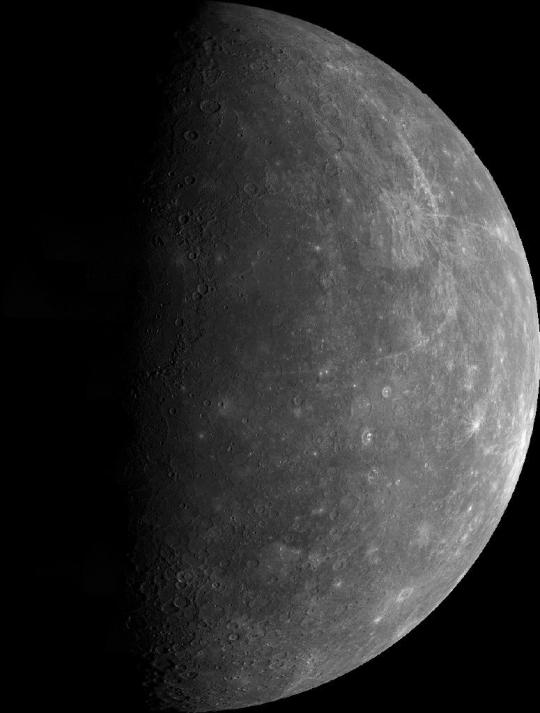
This mosaic shows the planet Mercury as seen by Mariner 10 as it sped away from the planet on March 29, 1974.
source x, x | images x
#mercurio#mercury#venus#mars#marte#astronomy#astronomia#space#solarsystem#sistemasolar#universe#universo#mariner#mission#space exploration
258 notes
·
View notes
Text
irredeamable development retrospective. Part 1.5: capitalism IN SPACE This one part will tackles an alternate setting for the Specter game we spoke of last time. It may even have come first in the development timeline, through it can be a bit difficult to determine exactly how and when ideas shifted so lets not worry about what actually came first. Much like shadow and light, this game was about a specter, possessing people, but just as the title says, the setting was more of a space-faring adventure where you would visit multiple planets.



It features much of the same races as shadows and light, though their exact appearance has shifted a bit, as everything would in a different setting.

Depicted here, we have Mars, a frozen desert planet with large scale mining operations and a bit of a western vibe. Humans and mitons are the main races here and were given stout figures and thick coat to fit the cold yet dry weather. Venus is now overgrown with a rich, volcanic jungle where countless comic plant are being grown and harvested. This planet is mainly occupied by goblin employees who take the place of the succubus from last game. Mercury was hollowed out and turned into a giant energy powerplant, with a massive solar panel attached to one side. Earth ...well i dont think i ever did figure out what to do with it. Its kind of just another mining planet. and finally we have the alien mothership. The home base of a group of invading alien corporations from the Alpha Centauri system. ....yes i know what it looks like, but its actually supposed to be based on their system having 3 stars (2 large and 1 small)

Aniway, the Centaurian species consists of long-lived and hyper-intelligent giant squid. Their technology is very advanced, especially in domains of communication, space travel and artificial life. Many of their servants (which i think included the goblins) are bioweapons that were specifically crafted to integrate into local populations and perform whichever jobs were needed for the growth of the company. There was never much of an actual story, so all i really got left are some blueprints of the solar system, now converted into some kind of space construct for the Centaurians to exploit.






Aniway, thats it for today, but next time we`ll be leaving all those specters behind and move into yet another setting. One that is not quite so cosmic, but instead rather....toweresque... To be continued in part 2: Ascending the Godlands
#game development#indiegamedev#irredeamable#solodev#indie games#scifi#fantasy#fantasy world#indiedev#game design#science fantasy#solar system#indie game dev#screenshotsaturday#gamedev#indie dev#corporations#late stage capitalism#fuck capitalism
35 notes
·
View notes
Text
i never thought i would see the word "hospital" in the same sentence as "bombarded" or "massacre."
and yet, injured and displaced civilians were massacred once again in the bombardment of al-Shifa Hospital. idf warplanes once again targeted three hospitals in the gaza strip : al-Shifa, al-Quds, and Indonesian Hospital.
what kind of self-defense requires you to airstrike ambulances full of the wounded? were infants blown to pieces "hamas"? in what kind of world do you have to document your grief and horror just for individuals across the world to believe and legitimize what you're going through and still have vile scum in the comments questioning it. but israel only has to claim people died and they receive aid and folks yawping for justice.
you'll hear zionists cry that they didn't MAKE Palestinians leave. meanwhile, israel cut electricity, contaminated the land's water resources, splashed boiling water or acid on Palestinian children, and threatened catastrophe after catastrophe if they didn't leave. the idf, who tie number tags on their hostages and assault them and humilate them further by recording their torment, also uses civilians as target practice if they stay or protest.
it's also worth repeating : israel controls the census and civil registration system in gaza. so every journalist and their families' murder is a deliberate act committed with the intent to further violate IHL and IHRL under which all war correspondents are protected. the geneva conventions are useless amidst all this.
the idf cut food and water and bombed bakeries.
they cut fuel and are now bombing solar panels.
the healthcare system in gaza has completely collapsed. doctors are performing surgeries on the floor.
israel has no purpose with the exception of inflicting unspeakable pain on a completely besieged population.
there are no words left. there is no apt vocabulary for this in the english language. i doubt there is in any vernacular.
how do you describe such barbaric cruelty in a language that humans speak?
44 notes
·
View notes
Text
Elevating Lifestyle Standards: Escon Panache’s Commitment to Sustainable Living and Safety & Security
At Escon Panache, we believe that true luxury extends beyond exquisite design and prime locations. It encompasses a commitment to sustainable living and ensuring the utmost safety and security for our residents. Here’s how Escon Panache Villas excels in these crucial areas, offering a harmonious blend of eco-friendly practices and cutting-edge security measures.

Sustainable Living: A Greener Tomorrow
Escon Panache is dedicated to fostering a sustainable lifestyle, integrating eco-friendly practices and technologies that not only benefit our residents but also contribute to the well-being of our planet.
Energy Efficiency
Our commitment to sustainability starts with energy efficiency. Escon Panache incorporates advanced energy-saving technologies, including LED lighting, energy-efficient appliances, and high-performance windows. These features significantly reduce energy consumption, lowering your carbon footprint and utility bills.
Renewable Energy Sources
Harnessing the power of renewable energy is at the core of Escon Panache’s sustainability initiatives. Our buildings are equipped with solar panels that generate clean, renewable energy, reducing dependence on non-renewable resources and promoting a greener environment.
Water Conservation
Water is a precious resource, and Escon Panache employs innovative water conservation techniques. Our properties feature rainwater harvesting systems, low-flow fixtures, and efficient irrigation systems that minimize water usage while maintaining lush, green landscapes.
Eco-Friendly Materials
The construction of Escon Panache utilizes sustainable building materials that are both durable and environmentally friendly. From recycled steel to sustainably sourced timber, every material is chosen to reduce environmental impact while ensuring the highest quality and longevity.
Green Spaces and Biodiversity
Escon Panache is designed with ample green spaces that enhance biodiversity and provide residents with a natural retreat. Our meticulously landscaped gardens, green roofs, and tree-lined pathways offer a serene environment, promoting physical and mental well-being.
Waste Management
Effective waste management is essential for a sustainable community. Escon Panache implements comprehensive recycling programs, composting systems, and waste segregation practices that minimize landfill contributions and encourage responsible waste disposal.
Safety and Security: Peace of Mind
At Escon Panache, the safety and security of our residents are paramount. We employ state-of-the-art technologies and robust security measures to ensure a secure living environment.
24/7 Surveillance
Our properties are equipped with advanced 24/7 surveillance systems, including high-definition CCTV cameras strategically placed throughout the premises. These systems are monitored by trained security personnel, ensuring constant vigilance and quick response to any incidents.
Controlled Access
Escon Panache prioritizes controlled access to enhance security. Our gated communities feature secure entry points with biometric or keycard access systems, ensuring that only authorized residents and guests can enter the premises.
Professional Security Personnel
Trained security personnel are present round-the-clock to maintain a safe environment. Our security team is equipped to handle emergencies and provide assistance to residents, offering peace of mind at all times.
Fire Safety Measures
Fire safety is a critical aspect of our security strategy. Escon Panache is equipped with modern fire detection and suppression systems, including smoke detectors, fire alarms, and sprinkler systems, ensuring prompt response and minimizing risk in case of a fire.
Emergency Preparedness
Escon Panache has comprehensive emergency preparedness plans in place. Regular drills and training sessions are conducted to ensure that residents and staff are well-prepared to handle emergencies efficiently and effectively.
Secure Parking Facilities
Our secure parking facilities are designed to protect your vehicles. Equipped with surveillance cameras and controlled access, our parking areas provide a safe environment for residents’ vehicles, preventing unauthorized access and theft.
Experience the Escon Panache Difference
Escon Panache Villas are more than just a residence; it’s a commitment to a better lifestyle. Our focus on sustainable living and unwavering dedication to safety and security create an environment where residents can thrive with peace of mind. Discover the Escon Panache difference, where luxury living meets responsible practices and top-tier security in its 4 BHK Villas in Greater Noida.
Visit Escon Panache today and embrace a lifestyle that’s safe, secure, and sustainable. Your future awaits.
Visit:-https://esconpanache.com/
Ref:-https://esconpanachevilla.blogspot.com/2024/06/elevating-lifestyle-standards-escon.html
Location: Greater Noida, Uttar Pradesh, India
#4bhkvillainnoida#4bhkluxuryvillas#4bhkvillaingreater noida#esconpanache#4bhkluxuriousvilla#esconpanachevillas#smartluxuryvilla
6 notes
·
View notes
Text
How Many Solar Panels Are Needed to Power a Home?
If you’ve ever wondered, “How many solar panels are needed to run a house?” you’re in the right place. Solar energy is becoming an increasingly popular choice for homeowners, and understanding how to size your system is essential to making it work for you.

Key Factors Affecting Solar Panel Requirements
To determine how many solar panels you need, consider these key factors:
Energy Consumption: Your energy usage directly impacts the number of panels required. Most homeowners aim to generate enough electricity to meet or exceed 100% of their energy needs.
Product Depreciation: Panel efficiency can be affected by age, weather conditions, and equipment inefficiency. Solar panels may not produce the exact power capacity they’re rated for due to these factors.
Roof Size & Shade: Roof space and shading can reduce your solar panel output. Panels facing east or west generally produce 25% less energy than those facing south.
Estimating Energy Consumption
To get an estimate of your home’s energy needs, review your latest electricity bill. Calculate your monthly energy consumption by averaging the total usage over the past year.
Determining Solar Panel Capacity
A typical solar panel generates about 270-330 watts. Depending on your location, the average solar panel can generate between 80-130 kWh per month. For most regions, the average monthly power generation is around 115 kWh.
How to Calculate the Number of Panels Needed
Find your average monthly energy usage.
Estimate your monthly solar power generation. In most areas, this is around 115 kWh.
Calculate the solar panel capacity needed by dividing your energy usage by solar panel output (typically 330 watts per panel).
For example, if your monthly usage is 500 kWh, you’d need around 5 panels to meet your needs (500 kWh ÷ 115 kWh = ~4.35 panels).
Choosing the Right System Size
There are two common system sizes:
3kW System: Produces around 12-15 units per day, costing about 3 lakh rupees and requiring around 300 square feet of space. This is ideal for smaller homes with moderate energy consumption.
5kW System: Ideal for homes consuming 3,000 to 4,000 kWh annually, this system generates more electricity, suitable for homes with higher energy needs. It’s often recommended for families with air conditioning or high-energy appliances.
Understanding Solar Power System Costs & ROI
Costs vary by region and brand, but solar energy systems typically offer excellent long-term savings by reducing electricity bills. Government incentives can further improve the return on investment (ROI), making it a financially sound decision over time.
Solar Panel Maintenance for Longevity
Routine maintenance, such as cleaning and regular inspections, is essential for keeping your solar panels running efficiently for more than 25 years. Monitoring energy production and addressing any performance issues promptly will ensure sustained efficiency.
Conclusion
Determining the right number of solar panels depends on your household’s energy usage, roof space, and local conditions. Whether you choose a 3kW or 5kW system, understanding your needs will help you select the ideal setup to power your home sustainably.
2 notes
·
View notes
Text
The Art of Renovation: Blending Tradition and Modernity in Construction
Renovation is more than a process of revamping spaces; it is an art form that combines tradition and modernity in construction. In today’s world, where historical significance meets contemporary needs, the challenge lies in maintaining a building's original character while updating it to meet modern standards. Renovators must balance preserving architectural integrity with introducing new materials, technologies, and designs. Here’s how experts blend these elements to create spaces that honor history while meeting the demands of the present.
Respecting Architectural Heritage
One of the key components of renovating historic buildings is respecting the original architecture. Many older structures are rich with distinctive details—like decorative moldings, brick facades, or intricate woodwork—reflecting past eras' craftsmanship. Renovation experts preserve these details even as they work to bring buildings up to date. They often consult architectural historians or preservation experts to ensure renovations honor the building's original character.
This commitment to heritage doesn’t mean that every building element must remain unchanged. In many cases, renovations can reimagine certain features while retaining their essence. For instance, restoring old windows rather than replacing them can help preserve a building's charm while allowing for better insulation and energy efficiency. By respecting architectural heritage, renovators make it possible for history and contemporary design to coexist harmoniously.
Integrating Modern Functionality
While preserving tradition is essential, a successful renovation also prioritizes modern functionality. Historical buildings were often designed with outdated layouts and infrastructure that may not align with today’s standards for comfort and efficiency. Renovators work to enhance these spaces by integrating modern amenities such as updated plumbing, electrical systems, and HVAC technology, all without disrupting the original aesthetic.
Modern functionality also involves making spaces more adaptable and practical. For example, open-plan layouts are often more desirable today than the compartmentalized rooms common in older buildings. Renovators can introduce more flexible, multifunctional areas by carefully reconfiguring interior walls and spaces. Blending modern needs with traditional elements requires creative problem-solving and meticulous planning, resulting in spaces that are both functional and respectful of their origins.
Using Sustainable Materials and Techniques
Incorporating sustainable practices is a growing priority in construction, and renovation is no exception. Using eco-friendly materials and techniques in renovations meets current environmental standards and ensures updated structures have a minimal carbon footprint. Many renovators opt for sustainable materials like reclaimed wood, recycled metal, and low-VOC paints to preserve the environment while retaining aesthetic quality.
Beyond material choice, renovators increasingly adopt sustainable techniques like energy-efficient windows, solar panels, and advanced insulation to improve energy performance. In older buildings, where traditional materials like brick and stone are already efficient insulators, these updates complement the building's strengths. This fusion of sustainable practices with traditional construction respects the structure’s history while enhancing its ecological footprint for future generations.
Embracing Contemporary Design Elements
Blending traditional architecture with contemporary design elements allows renovations to celebrate the past and present. Renovators often introduce modern touches—such as minimalist fixtures, sleek glass panels, and open spaces—to contrast with and highlight a building's historical elements. This juxtaposition creates a dynamic look, allowing original features to stand out rather than be overwhelmed by modern additions.
In many cases, contemporary designs can bring new life to spaces without overshadowing their heritage. For example, adding a modern staircase with clean lines and simple finishes can complement traditional woodwork or stone walls. When done thoughtfully, contemporary design elements enhance rather than detract from the original structure, resulting in a visually striking and balanced renovation that appeals to modern sensibilities while honoring historical roots.
Balancing Old and New with Thoughtful Interior Design
Interior design plays a crucial role in harmonizing traditional and modern aesthetics. A successful renovation often involves working with interior designers who understand the nuances of blending different styles. Designers create cohesive spaces where every element feels intentionally placed by using furniture, textiles, and decor that bridge the gap between old and new.
For example, incorporating antique furniture alongside contemporary artwork can create a balanced and visually appealing interior. Designers also use color schemes and lighting techniques to accentuate original architectural features, making them focal points in a modernized setting. The thoughtful interior design ensures that the blend of old and new is seamless, giving renovated spaces a timeless quality that respects their heritage while embracing the future.
The art of renovation is a delicate dance between tradition and modernity, requiring an understanding of architectural history, a commitment to functionality, and a respect for sustainability. By balancing old and new elements, renovators create spaces that honor the past while meeting present-day needs. This fusion allows renovated buildings to become functional spaces and symbols of continuity, showing that progress and preservation coexist. In blending tradition with modernity, the construction industry is building a future that cherishes the past while looking ahead.
2 notes
·
View notes
Text
best houseboat in alleppey? , best boathouse in alleppey ?

Discover the Best of Alleppey Backwaters with MayooramCruises
If you're dreaming of floating along the tranquil backwaters of Kerala, Mayooram Cruises invites you to experience the magic of Alleppey in the most luxurious and authentic way possible. Known as the "Venice of the East," Alleppey is famed for its serene canals, lush greenery, and traditional houseboats that offer a glimpse into the unique way of life in Kerala's backwaters.
Why Choose MayooramCruises?
At Mayooram Cruises, we pride ourselves on offering a blend of luxury, comfort, and tradition, ensuring that your houseboat journey through Alleppey's backwaters is nothing short of extraordinary. Whether you're planning a romantic getaway, a family vacation, or a peaceful retreat, our houseboats are designed to cater to all your needs with elegance and charm.
The Mayooram Houseboat Experience
Luxurious Floating Comfort Our houseboats are beautifully crafted with modern amenities while retaining the charm of Kerala’s rich cultural heritage. From air-conditioned bedrooms to spacious living areas and private decks, you’ll enjoy every moment in comfort. With options ranging from 1-bedroom romantic suites to multi-bedroom boats for families and groups, Mayooram Cruises has the perfect option for your stay.
Scenic Backwater Routes Our cruises take you through some of the most picturesque routes in Alleppey, passing by vibrant paddy fields, swaying coconut palms, and charming villages. Marvel at the natural beauty and witness the daily life of locals along the backwaters as you cruise past quaint fishing villages, ancient temples, and lush landscapes.
Culinary Delights At Mayooram Cruises, dining is an experience in itself. Our onboard chefs prepare fresh, authentic Kerala cuisine that showcases the region’s diverse culinary heritage. Whether it’s the famous Karimeen Pollichathu, the mouthwatering Prawn Curry, or vegetarian delights like Avial and Sambar, every meal is a feast. We also offer customizable menu options to suit your preferences.
Personalized Service We believe in making your stay as special as possible. Our dedicated crew is on hand to provide exceptional service, from guiding you through the cruise to ensuring all your needs are met. Enjoy warm hospitality, personalized care, and attention to detail throughout your journey with us.
Exclusive Experiences With Mayooram Cruises, your trip is more than just a boat ride. You can explore hidden gems like local villages, take guided walks to learn about coir-making, or try your hand at fishing with the locals. For a more immersive experience, ask us about arranging cultural performances, like traditional Kathakali or Mohiniyattam dances, right onboard your houseboat.
Perfect for All Occasions
Whether it’s a honeymoon, an anniversary celebration, or a family vacation, Mayooram Cruises offers tailored experiences to suit your occasion. Opt for a romantic candlelight dinner under the stars, or plan a day cruise with your family filled with activities and adventures.
Sustainability at Heart
At Mayooram Cruises, we are committed to preserving the beauty of Alleppey’s backwaters. Our houseboats are equipped with eco-friendly technologies such as solar panels, responsible waste management systems, and energy-efficient lighting, ensuring that our operations have a minimal environmental impact.
Book Your Dream Cruise
Mayooram Cruises offers a range of customizable packages to ensure you have the perfect backwater getaway. Whether you want a short day cruise or a multi-night experience, we provide flexible options that suit your schedule and budget.https://mayooramcruises.tours/
Come and Experience Alleppey's Backwaters with MayooramCruises Embark on a journey with Mayooram Cruises to explore the tranquil beauty of Kerala's backwaters in ultimate style and comfort. Let us show you the true essence of Alleppey, where nature, culture, and luxury converge for an unforgettable houseboat experience.
https://mayooramcruises.tours/
#kerala#kerala tourism#tourism#houseboat#tourist#houseboats#traveling#travel#best houseboats in alleppey#best boathouse in alleppey#alleppey boathouse#alleppey houseboats#top rated houseboats in alleppey#alappuzha#alleppey#houseboat alappuzha#best backwater resorts in alleppey
2 notes
·
View notes
Text
Aquarians Radio invites: IbuProPhet (de) @ Holy Night Studio, Santiago Chile 2024
Follow IbuProPhet: https://dj-bike.de/about/

Ian Jakab, aka IbuProPhet, believes that sound and music are mediums to share moments, ideas, feelings, and experiences that bring people together. He enjoys playing his wide range of records with the DJ-BIKE and adapting his DJ sets to the needs of each event. Music styles can range from Jazz to Techno, from Soul to Classical Music, from Afro-funk to Neue Deutsche Welle, and from Cumbia to Italo Disco. He works also booking and curating other DJs from his extensive network. He's project DJ-BIKE, created in 2021, is a customized tricycle with a rear loading area, constructed sustainably using mostly recycled parts from old bicycles. Solar panels on the roof generate power for the motor and sound system, ensuring self-sufficiency. Conceived in 2021 for the public space performance series “Soundtrack für die Stadt” in Munich, this mobile platform serves as a tool for local and international subcultural artists to display their art in unexpected city locations. Annually it is invited to various socio-cultural and artistic contexts, serving as a sound system for DJs and live artists. It offers a flexible, unconventional, and sustainable service to institutions, organisations, associations, as well as private individuals and fair companies wishing to musicalize special events.

A bicycle equipped with a sound system represents more than just a mobile stage for artists; it embodies a profound social experiment. By taking art to unexpected places, it challenges the traditional confines of performance and invites diverse communities to engage with creativity in their everyday environments. This initiative, much like successful projects in Germany, showcases the power of art to bridge divides, fostering connections among people who might otherwise remain isolated.
In a world often marked by disconnection, these spontaneous performances serve as reminders of our shared humanity. They open up spaces for dialogue, reflection, and active participation, transforming mundane settings into vibrant cultural hubs. The sounds and rhythms can evoke contemplation and active meditation, allowing individuals to reconnect with their essence. Such cultural interventions not only enrich lives but also act as a counterforce to modern forms of enslavement, highlighting the vital role of art in healing and community building. Through this lens, we can envision a more connected, expressive society.
#world music#deejay#vinyl records#vinylcollection#records#musique#radio#munchen#germany#santiago#record labels#ibuprophet#djbike#Youtube#bass music#turkish#jaddah
3 notes
·
View notes
Text
A gastroenterologist's warning about Finns' fatty livers is grabbing the attention of Helsingin Sanomat readers.
"It is alarming that working-age people in their prime are dying from liver diseases. The most common is fatty liver, which already affects every third person in Finland," gastroenterologist Ville Männistö of the University of Eastern Finland told HS.
Männistö points out that fatty liver is often either associated with alcohol or excess weight, but less attention is paid to the combined effect of these risk factors — which is the situation in Finland. Not only do half of Finns have excess abdominal fat, but many working-age people here drink too much as well.
In Finland, liver cirrhosis mortality is on the rise and the UK appears to be the only other country with a similar trajectory, according to Männistö, who says the other Nordics and Western European countries have bucked this trend.
Bonus controversy
Hufvudstadsbladet follows up on Helsinki University Hospital's bonus system. HUS paid out around 454,000 euros in performance bonuses to its executives this spring, even though nearly 1,000 employees face redundancy.
The 26 highest-ranking HUS executives received annual bonuses of tens of thousands of euros, depending on their performance. These execs have fixed salaries ranging from 10,000 to 15,000 euros per month.
HBL now reports that several high-ranking individuals at HUS are critical of the system — but not because they should have seen less money.
"I didn't receive my full salary because the model doesn't work," Maaret Castrén, former director of emergency departments in Uusimaa and one of the 26 who received bonuses, told the Swedish-language daily.
Castrén, now a National Coalition Party MP, explained that the bonuses were a part of the total salary package.
To cast further light on the situation, Castén provides an example of how the system worked in her case. To meet her targets, patients needed to transfer out of emergency units to other departments within eight hours — a goal she said hinged on matters beyond her control, such as the capacity of other divisions.
Harnessing the sun
As the days grow shorter, business daily Kauppalehti reports that solar energy is gaining ground in Finland. A few years ago, the general sentiment was that it wasn't worthwhile to produce solar energy in Finland, but that viewpoint has changed.
Solar panels are becoming increasingly efficient, according to the business daily. Panels these days need smaller surface areas to produce the same amount of electricity.
Solar energy is starting to make a significant impact on Finland's electricity system. KL notes that the abundance of solar power is already influencing electricity prices during the bright summer hours.
The Energy Authority estimates that by 2030, the production capacity of large solar power plants could be 190 times greater than today.
4 notes
·
View notes
Text
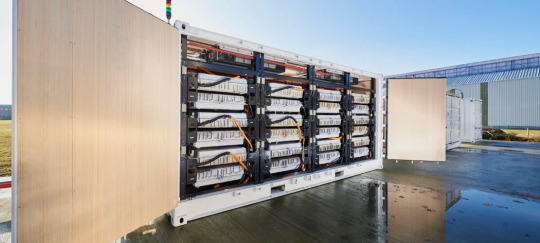
[In February, 2023], a small warehouse in the English city of Nottingham received the crucial final components for a project that leverages the power of used EV batteries to create a new kind of circular economy.
Inside, city authorities have installed 40 two-way electric vehicle chargers that are connected to solar panels and a pioneering battery energy storage system, which will together power a number of on-site facilities and a fleet of 200 municipal vehicles while simultaneously helping to decarbonize the UK’s electrical grid.
Each day Nottingham will send a combination of solar-generated energy — and whatever is left in the vehicles after the day’s use — from its storage devices into the national grid. The so-called “vehicle to grid” chargers deliver this energy just when it’s needed most, during peak evening demand, when people are home cooking, using hot water or watching TV. Later, the same chargers pull energy from the grid to recharge the vehicles in the wee hours of the night, when folks are sleeping and electricity is cheaper and plentiful.
“We are trying to create a virtual power station,” says Steve Cornes, Nottingham City Council’s Technical Lead. “The solar power and battery storage will help us operate independently and outside of peak times, making our system more resilient and reducing stress on the national grid. We could even make a profit.” ...
After around a decade, an EV battery no longer provides sufficient performance for car journeys. However, they still can retain up to 80 percent of their original capacity, and with this great remaining power comes great reusability.
“As the batteries degrade, they lose their usefulness for vehicles,” says Matthew Lumsden, chairman of Connected Energy. “But batteries can be used for so many other things, and to not do so results in waste and more mining of natural resources.”
The E-STOR hubs come in the form of 20-foot modular containers, each one packed with 24 repurposed EV batteries from Renault cars. Each hub can provide up to 300kW of power, enough to provide energy to dozens of homes. One study by Lancaster University, commissioned by Connected Energy, calculated that a second life battery system saved 450 tons of CO2 per MWh over its lifetime...
Battery repurposing and recycling is set to play a massive role over the coming years as the automobile industry attempts to decarbonize and the world more broadly attempts to fight waste. The production of EVs, which use lithium-ion batteries, is accelerating. Tesla, for example, is aiming to sell 20 million EVs per year by 2030 — more than 13 times the current level. In turn, 12 million tons of EV batteries could become available for reuse by 2030, according to one estimate.
“Over the next decade we are going to see this gigantic wave,” says Jessica Dunn, a senior analyst at the Union of Concerned Scientists. “Companies are recognizing this is a necessary industry. They need to ramp up infrastructure for recycling and reuse.”
-via Reasons to Be Cheerful, March 13, 2023
#ev#ev charger#electric vehicle#electric cars#batteries#battery recycling#lithium ion battery#auto industry#sustainability#circular economy#recycling#reuse#uk#nottingham#england#good news#hope
217 notes
·
View notes